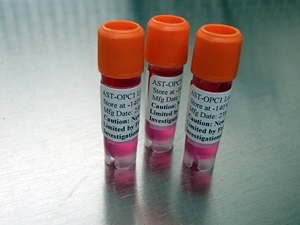5 March 2015. A clinical trial testing a stem cell therapy for spinal cord injury is recruiting patients at an Atlanta rehabilitation center. The intermediate-stage trial, conducted by biotechnology company Asterias Biotherapeutics, aims to initially enroll 13 adults to test three dosage levels of neural stem cells designed to restore motor functions to spinal cord injury victims.
Spinal cord injuries are usually caused by a sudden, traumatic blow to the spine that bruises or tears into spinal cord tissue, resulting in fractures or compression to vertebrae, or in some cases severing of the spinal cord. Depending on severity, people with spinal cord injuries often suffer loss of feeling or motor function in the limbs, and in some cases complete paralysis. According to the National Spinal Cord Injury Statistical Center, spinal cord injuries occur in 40 out of 1 million people in the U.S., adding some 12,500 new cases each year.
Asterias, in Menlo Park, California, acquired stem cell therapies in development by Geron Corporation, including a treatment for spinal cord injury that Asterias code-names OPC1. The treatments are derived from human embryonic stem cells, which are cultured into oligodendrocyte progenitor cells, then transplanted to regenerate into functioning spinal cord nerve cells. Studies with lab animals show transplanted human oligodendrocyte progenitor cells are capable of restoring some limb functions.
In an early-stage safety test of OPC1, Asterias says 5 patients with spinal cord injuries at the Shepherd Center, a rehabilitation hospital in Atlanta for people with spinal cord injuries, showed the patients suffered no adverse effects from the treatments, the trial’s main objective. In 4 of the 5 patients, who suffered their injuries 7 to 14 days prior to the treatments, MRI scans revealed reduced hollowing out of spinal cord tissue may have occurred, suggesting at least some therapeutic benefit from the treatments.
The next clinical trial will also test for safety of the treatments, but will give the 14 patients with recent injuries — 14 to 30 days following the event — single injections of 2 million or 10 million OPC1 cells, or 2 injections of 10 million cells. The study also plans to evaluate the patients’ neurological functions based on a standard scale of motor capabilities at various intervals, up to 1 year following the injections. The new trial, also at the Shepherd Center, is funded by a $14.3 million grant from the California Institute for Regenerative Medicine.
Asterias says it plans to accelerate the schedule for the new trial and ask the U.S. Food and Drug Administration for permission to expand the study to 40 patients. In November 2011, Geron halted its work on stem cell treatments for spinal cord injuries to focus on cancer therapies, which the company’s CEO attributed to “the current environment of capital scarcity and uncertain economic conditions.”
Read more:
- Adult Stem Cell Quality Control Methods Devised
- Synthetic Bone Marrow System Produces Platelets
- Stem Cells Shown Effective with Autism in Lab
- Stem Cells Engineered to Produce Insulin-Making Cells
- Investment Fund Launches to Support Stem Cell Ventures
* * *


 RSS - Posts
RSS - Posts
You must be logged in to post a comment.